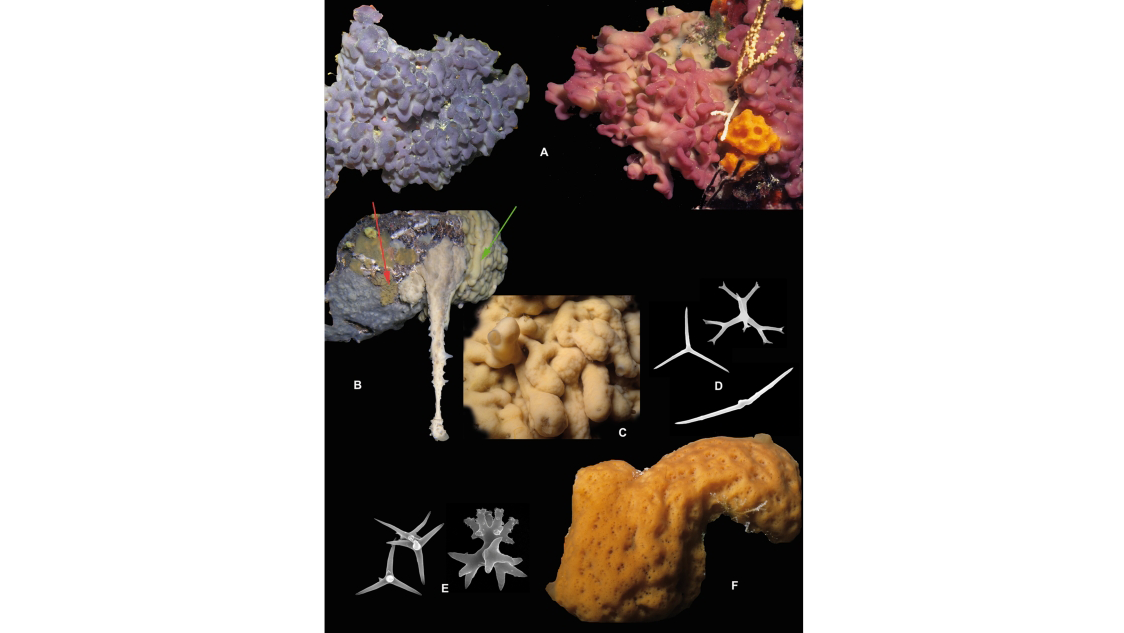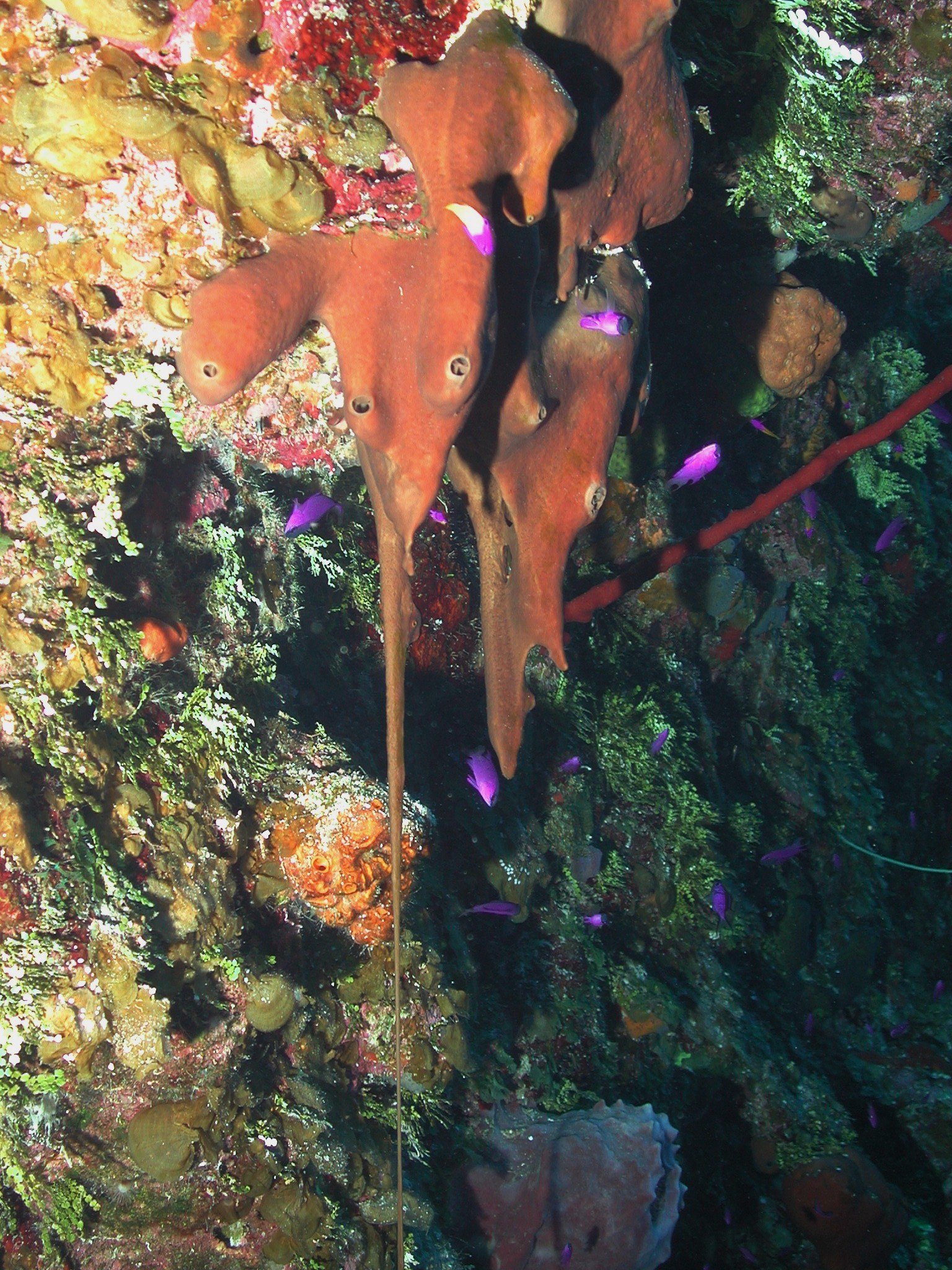Chapter contents:
Porifera
–– 1. Archaeocyatha
–– 2. Stromatoporoidea
–– 3. Demospongiae
–– 4. Hexactinellida
–– 5. Calcarea
–– 6. Homoscleromorpha ←
Above images from left to right are: Left image by: Parent Géry (Wikimedia Commons; Public Domain). Center image by: 'Waielbi' (Wikimedia Commons; Creative Commons Attribution-Share Alike 3.0 Public Domain Dedication). Right image by: Philippe Bourjon (Wikimedia Commons; Creative Commons Attribution-Share Alike 4.0 Public Domain Dedication).
Class Homoscleromorpha Snapshot
- Examples: encrusting sponges
- Ecology: marine
- Key features of group: leucon body form, small tetraxonic silica spicules if present
- Diversity: ~123 living sp.
- Fossil record: Jurassic to Recent
Overview
Homoscleromorpha, the smallest class of Porifera, was originally considered part of Demospongiae. However due to advances in using genetic data to reconstruct sponge phylogeny, this newly recognized clade was discovered. Homoscleromorpha is now recognized as the fourth class of sponges.
Homoscleromorphs have an extremely poor fossil record due to their tiny spicules and encrusting forms, which rarely preserve well. They have a leucon body plan and small tetraxon spicules. A few preserved spicules from the Carboniferous could potentially be from a homoscleromorph sponge, but definitive records are only known from the Mesozoic.

Highly simplified overview of porifera phylogeny based in part on the hypothesis of relationships presented by Botting and Muir (2018). Image by Jaleigh Q. Pier, licensed under a Creative Commons Attribution-ShareAlike 4.0 International License.

Sponge leucon body plan modified from original image by 'Philcha' (Wikimedia Commons; Creative Commons Attribution-Share Alike 3.0 Public Domain Dedication). Spicule image by Jaleigh Q. Pier is licensed under a Creative Commons Attribution-ShareAlike 4.0 International License.
Cryptic Habitats
Homoscleromorpha are exclusively marine sponges that tend to encrust on other surfaces at shallow depths. Recent studies are exploring sponge diversity within cave environments, where Homoscleromorpha may be more prevalent. In one study, 70% of all Homoscleromorpha families and genera of the Mediterranean Sea were discovered within caves of the region. This might suggest that under-explored areas and cryptic habitats might just be where these unique sponges thrive (Gerovasileiou and Voultsiadou, 2012).

Homoscleromorpha. Original caption: "A. Oscarella lobularis (Oscarellidae): two color morphs from NW Mediterranean Sea (photos courtesy of Jean Vacelet & Thierry Pérez); B. Plakortis simplex (Plakinidae) specimen hanging from the ceiling of the 3PPs cave (NW Mediterranean Sea), a paradise for Homoscleromorpha species (at least 8 species belonging to 4 different genera are present); red arrow indicates the presence of Oscarella microlobata and a green arrow Plakina jani (photo courtesy Thierry Pérez); C. Plakina jani (Plakinidae) detail of the lobes, 3PPs cave (NW Mediterranean Sea) (photo courtesy Jean Vacelet); D. Spicules of Plakinidae: triods, diods and lophose calthrops; E. Spicules of Corticium candelabrum (Plakinidae): calthrops and candelabrum (heterolophose calthrops); F. Corticium candelabrum NW Mediterranean Sea (photos courtesy of Jean Vacelet)." By (Van Soest et al., 2012) (Wikimedia Commons; Creative Commons Attribution-Share Alike 3.0 Public Domain Dedication).
Living Homoscleromorpha:
Living homoscleromorph sponges can be divided into two families; Oscarellidae and Plakinidae. Although they are very similar, Plakinidae have structural spicules while Oscarellidae are spicule-free.
Family Oscarellidae:

Oscarella lobularis. Image by: 'Waielbi' (Wikimedia Commons; Creative Commons Attribution-Share Alike 3.0 Public Domain Dedication).

Oscarella lobularis. Image by: Parent Géry (Wikimedia Commons; Public Domain).
Family Plakinidae:

Plakortis sp. Image by: Philippe Bourjon (Wikimedia Commons; Creative Commons Attribution-Share Alike 4.0 Public Domain Dedication).

A sea cucumber on a chicken liver sponge (Plakortis sp.) Image by: Nick Hobgood (Wikimedia Commons; Creative Commons Attribution-Share Alike 3.0 Public Domain Dedication).

A strange liver sponge. Image by: NOAA (Wikimedia Commons; Creative Commons Attribution-Share Alike 2.0 Generic License).
References and further reading:
Botting, J.P, and Muir, L.A. 2018. Early sponge evolution: A review and phylogenetic framework. Palaeoworld: 27, pp. 1-29.
Boury-Esnault, N., Lavrov, D.V., Ruiz, C.A., Pérez, T., 2013. The Integrative Taxonomic Approach Applied to Porifera: A Case Study of the Homoscleromorpha, Integrative and Comparative Biology, 53(3), pp. 416–427, https://doi.org/10.1093/icb/ict042
Gazave, E. et al. 2012. No longer Demospongiae: Homoscleromorpha formal nomination as a fourth class of Porifera. Hydrobiologia: 687, pp. 3-10.
Gerovasileiou, V., and E. Voultsiadou, 2012. Marine Caves of the Mediterranean Sea: A Sponge Biodiversity Reservoir within a Biodiversity Hotspot. PLoS ONE: 7(7), pp. 17.
Van Soest, R.W.M., et al. 2012. Global Diversity of Sponges (Porifera). PLoS ONE: 7(4), pp. 1-23.
Usage

Unless otherwise indicated, the written and visual content on this page is licensed under a Creative Commons Attribution-NonCommercial-ShareAlike 4.0 International License. This page was written by Jaleigh Q. Pier. See captions of individual images for attributions. See original source material for licenses associated with video and/or 3D model content.



